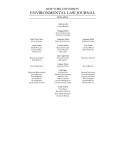Author: Danielle Spiegel-Feld
 Nationwide, Americans pump approximately eighty-three billion gallons of groundwater per day. 1This staggering rate of withdrawal is unsustainable in many areas and jeopardizes the longevity of one of our most vital natural resources.
Nationwide, Americans pump approximately eighty-three billion gallons of groundwater per day. 1This staggering rate of withdrawal is unsustainable in many areas and jeopardizes the longevity of one of our most vital natural resources.
Several authors have proposed extending the public trust doctrine 3 to groundwater to force greater conservation. They hope that if the public trust doctrine were expanded to include groundwater as a trust asset, states would be prevented from issuing permits for withdrawals that imprudently deplete this resource. Even more enticingly, the doctrine may present an opportunity to redefine existing rights where a resource has already been over-appropriated, such as is presumably the case wherever groundwater mining legally occurs (i.e., where the rate of extraction consistently exceeds the rate of recharge).
The seventeen states in the arid American West extract the great majority of the groundwater in the nation. Therefore, if the public trust doctrine is to provide a meaningful solution to groundwater mining, it must extend into the West’s subterranean waters. So far, however, the movement to incorporate groundwater protection into the public trust doctrine has only gained traction in the nation’s wet states. In fact, while four wet states have explicitly expanded the public trust to include groundwater – Hawaii, New Hampshire, Tennessee, and Vermont – no western state has done so.
This note examines the prospects for expanding the public trust doctrine to incorporate groundwater conservation in the West, where it is needed most.
Download this publication here.
